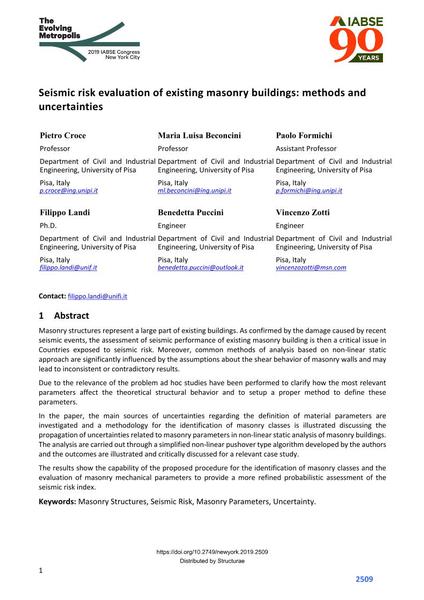Seismic risk evaluation of existing masonry buildings: methods and uncertainties

|
|
|||||||||||
Bibliographic Details
| Author(s): |
Pietro Croce
Maria Luisa Beconcini (Department of Civil and Industrial Engineering, University of Pisa) Paolo Formichi (Department of Civil and Industrial Engineering, University of Pisa) Filippo Landi (Department of Civil and Industrial Engineering, University of Pisa) Benedetta Puccini (Department of Civil and Industrial Engineering, University of Pisa) Vincenzo Zotti (Department of Civil and Industrial Engineering, University of Pisa) |
||||
|---|---|---|---|---|---|
| Medium: | conference paper | ||||
| Language(s): | English | ||||
| Conference: | IABSE Congress: The Evolving Metropolis, New York, NY, USA, 4-6 September 2019 | ||||
| Published in: | The Evolving Metropolis | ||||
|
|||||
| Page(s): | 2509-2514 | ||||
| Total no. of pages: | 6 | ||||
| DOI: | 10.2749/newyork.2019.2509 | ||||
| Abstract: |
Masonry structures represent a large part of existing buildings. As confirmed by the damage caused by recent seismic events, the assessment of seismic performance of existing masonry building is then a critical issue in Countries exposed to seismic risk. Moreover, common methods of analysis based on non-linear static approach are significantly influenced by the assumptions about the shear behavior of masonry walls and may lead to inconsistent or contradictory results. Due to the relevance of the problem ad hoc studies have been performed to clarify how the most relevant parameters affect the theoretical structural behavior and to setup a proper method to define these parameters. In the paper, the main sources of uncertainties regarding the definition of material parameters are investigated and a methodology for the identification of masonry classes is illustrated discussing the propagation of uncertainties related to masonry parameters in non-linear static analysis of masonry buildings. The analysis are carried out through a simplified non-linear pushover type algorithm developed by the authors and the outcomes are illustrated and critically discussed for a relevant case study. The results show the capability of the proposed procedure for the identification of masonry classes and the evaluation of masonry mechanical parameters to provide a more refined probabilistic assessment of the seismic risk index. |
||||
| Keywords: |
uncertainty Seismic Risk Masonry Structures Masonry Parameters
|
||||
